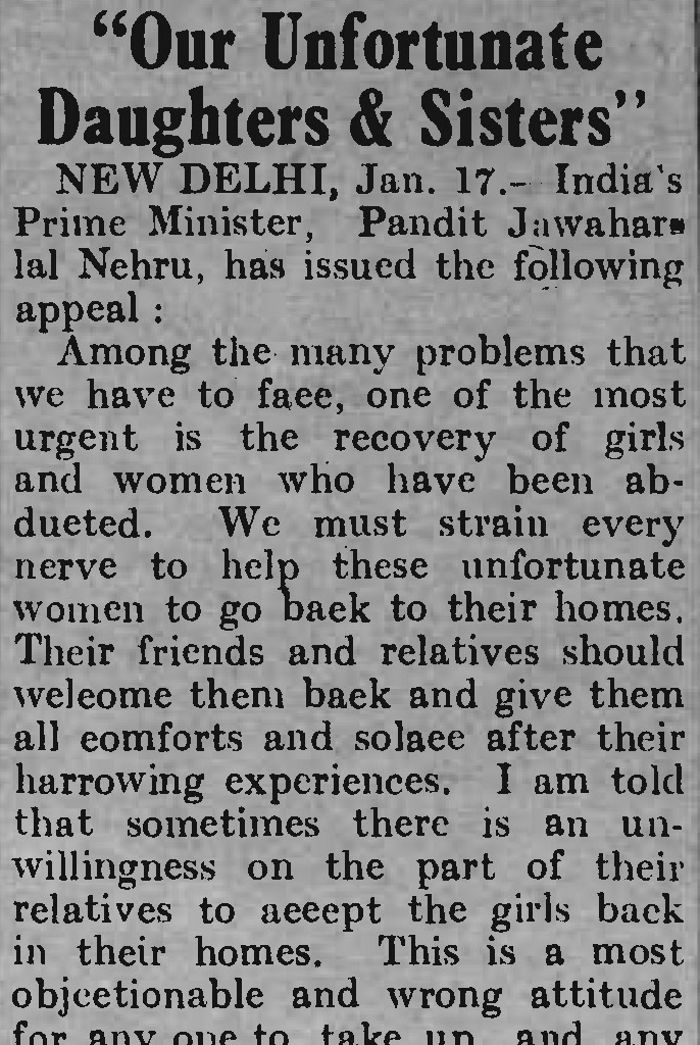
How 2 women led the mission to rescue 30,000 abductees
Vishav Bharti
Chandigarh, August 9
Monumental efforts of two women helped rescue 30,000 abducted women in eight years between 1948 and 1956 after the Partition.
Mridula Sarabhai and Rameshwari Nehru, who hailed from prominent families, were instrumental in rescuing the abducted women on both sides of the border.
In all, 20,728 Muslim women were rescued — a figure that overshadows the number of non-Muslims rescued. A total of 9,032 non-Muslim women were saved.
According to the official estimate, 50,000 Muslim women in India and 33,000 non-Muslim women in Pakistan were abducted.

Historian Ramachandra Guha records the contribution of Mridula Sarabhai and Rameshwari Nehru in his masterpiece book “India After Gandhi”.
He writes, “hellip;after the dust had settled down and the blood dried, the governments of India and Pakistan agreed that these captured women must be returned to their original families. On the Indian side, the operation to recover abducted women was led by Mridula Sarabhai and Rameshwari Nehru. Both came from aristocratic homes and both had sturdily nationalist credentials. Their work was encouraged and aided by Jawaharlal Nehru, who took a deep personal interest in the process.”
Rameshwari Nehru’s commitment to the cause of abducted women was so firm that Shobha Nehru (wife of former Indian envoy to the US BK Nehru) recalled in an interview around a decade ago that “Rameshwari Nehru refused to leave Lahore until all women refugees in the camps were evacuated. Neither Mr Jawaharlal Nehru nor her son could make her leave. Eventually, the family’s Muslim friend in Lahore managed this difficult task”.
On December 6, 1947, at the Inter-Dominion Conference in Lahore, the two countries agreed to take steps for rescuing and restoring the women to the two countries, while Mridula Sarabhai was appointed the chief social worker. She continued with her efforts for the next decade.
Ritu Menon and Kamla Bhasin recounted the situation in those days in their paper titled “Abducted Women, the State, and Question of Honour”. They write that “communal tension and the ensuing violence escalated at such a rapid pace, especially after March 1947, that on September 3, 1947, leaders and the representatives of the governments of India and Pakistan met and resolved that steps be taken to recover and restore abducted persons”.
Between December 1947 and July 1948, a total of 9,362 women from India and 5,510 from Pakistan were rescued.
To speed up the process, an agreement was reached between India and Pakistan on November 11, 1948, that set out the terms for rescuing women in each dominion. Ordinances were issued in both countries. These remained in force till January 1950 in Pakistan.
Till December 1949, a total of 12,000 women were rescued in India and 6,000 in Pakistan. The official figures make it clear that of those rescued, the majority were below the age of 35 and primarily from rural areas.
Ritu Menon and Kamla Bhasin wrote that about 30,000 women were recovered by both countries over a period of eight years.
A majority of women were rescued between 1947 and 1952, but the process of women returning to their countries dragged on till 1956. The agreement was renewed every year in India till 1957, when it was allowed to lapse. The rescue operation was more or less abandoned in two or three years prior to this, largely because Mridula Sarabhai came in for some adverse criticism, and resigned.
Duo at the forefront
Mridula Sarabhai: A freedom fighter and politician, she belonged to the Sarabhai industrialist family of Ahmedabad. She was sister of scientist Vikram Sarabhai.
Rameshwari Nehru: An honorary adviser to the Ministry of Rehabilitation, she played a vital role in rescuing abducted women and children. She married Brijlal Nehru, a nephew of Motilal Nehru and cousin of Jawaharlal Nehru.
‘Nehru took personal interest’
“hellip;after the dust had settled down and the blood dried, the governments of India and Pakistan agreed that these captured women must be returned to their original families. On the Indian side, the operation to recover abducted women was led by Mridula Sarabhai and Rameshwari Nehru. Both came from aristocratic homes and both had sturdily nationalist credentials. Their work was encouraged and aided by Jawaharlal Nehru, who took a deep personal interest in the process.” — India After Gandhi by Ramachandra Guha
